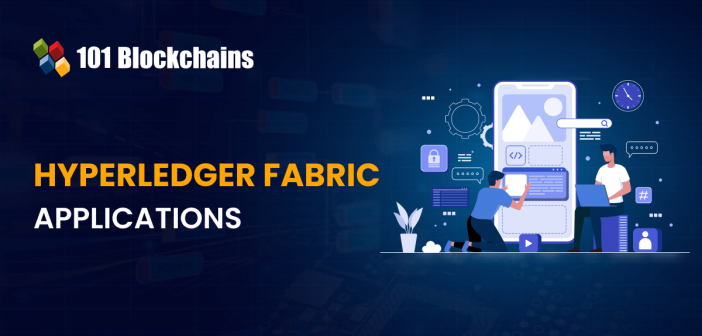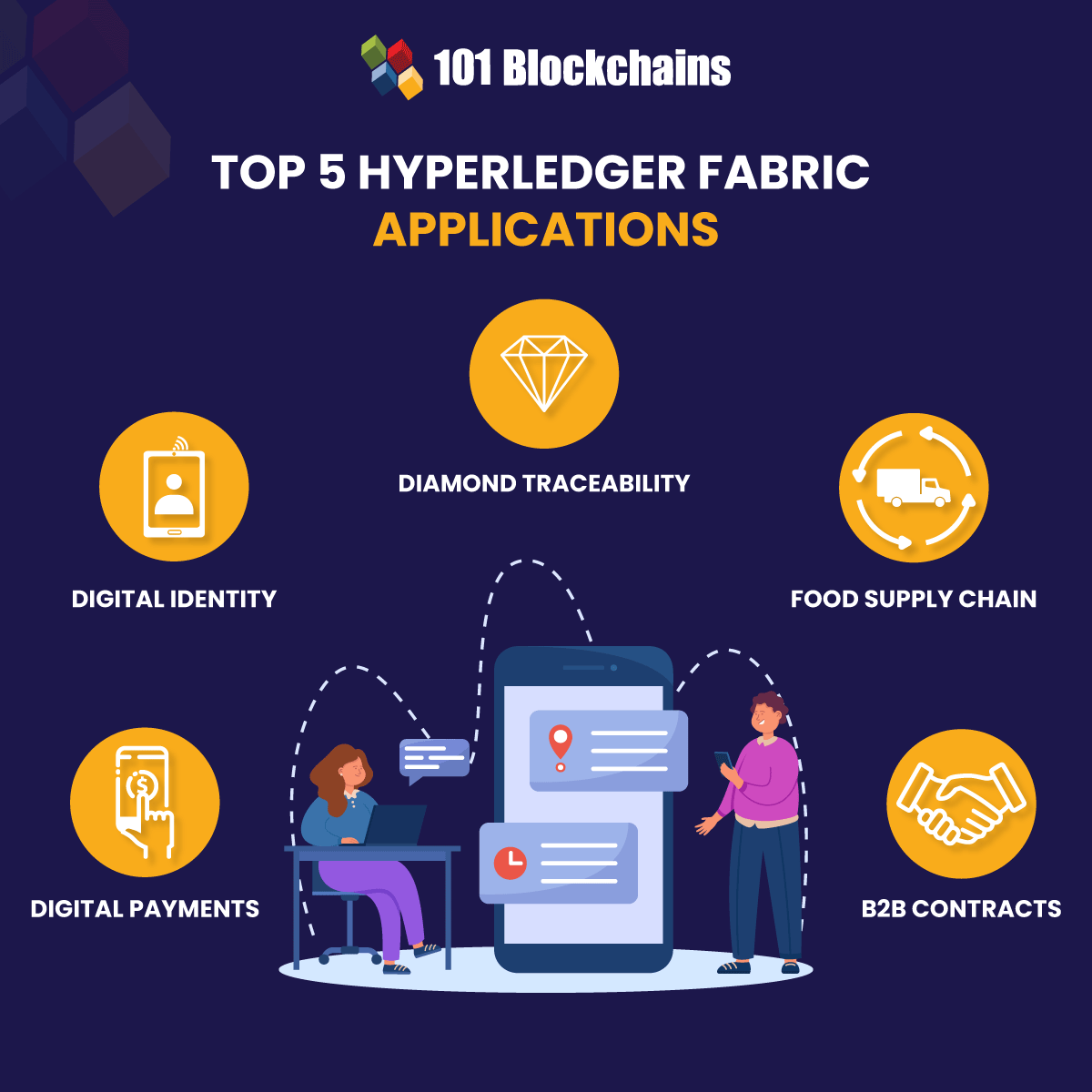Learn how blockchain truly works, master key definitions, and uncover what makes smart contracts so "smart." Dive into the fundamentals, gain valuable insights, and start your blockchain journey today!

- Guides
James Howell
- on June 17, 2022
Top 5 Hyperledger Fabric Applications
The expansion of blockchain technology and innovative developments have put forward some conclusive highlights regarding the potential of blockchain. Among the many popular blockchain frameworks, Hyperledger Fabric has carved a unique reputation to its name. Many aspiring blockchain professionals want to figure out Hyperledger Fabric applications and implement them in real life.
Hyperledger emerged in mainstream discussions in 2016 as an open-source collection of projects and tools tailored specifically for streamlining blockchain development tasks. The efficiency of Hyperledger depended profoundly on better collaboration between the developers and businesses engaged with distributed ledger technologies.
As the adoption of blockchain applications continues to grow, enterprises are seeking the right solutions to make the most of blockchain. How will Hyperledger applications help in such cases? The following discussion helps you uncover the different applications of Hyperledger Fabric with a detailed overview of the platform’s significance.
Want to learn blockchain technology in detail? Enroll Now in Certified Enterprise Blockchain Professional (CEBP) Course
Definition of Hyperledger Fabric
The first thing you need to learn before any Hyperledger Fabric application example would refer to its definition. A better understanding of the tool itself can provide the best foundation for learning about its applications in detail. Hyperledger Fabric is basically an enterprise distributed ledger framework with two significant traits suited for different blockchain use cases.
The two distinct traits include references to versatility and modularity. With the modular architecture of Hyperledger Fabric, you can easily accommodate the diverse range of industry use cases pertaining to blockchain technology. Users can make the most of Hyperledger blockchain applications with effective use of plug-and-play elements such as permissioned services, consensus, and privacy. How does Hyperledger Fabric ensure value for different use cases related to blockchain?
Features of Hyperledger Fabric
The answer to questions about the capabilities of Hyperledger Fabric would ultimately round up in the features of the tool. Here are some of the notable features of Hyperledger Fabric that define its functionalities.
- Limited latency for finality or confirmation.
- Highly modular and permissioned architecture.
- Open smart contract model tailored for imparting flexibility in the implementation of any solution model.
- Plug-and-play elements in consensus.
- Support for Solidity and EVM.
- Multi-language smart contract support for different languages such as JavaScript, Go, and Java.
- Facility of continuous operations such as asymmetric version support and rolling upgrades.
- Flexible data privacy approaches with data isolation through channels and exclusive data sharing through private data collections.
- Support for JSON queries and key-based queries.
All these features show why Hyperledger applications can offer a definitive advantage to developers. Anyone interested in identifying the best ways to put Hyperledger Fabric to practical use must understand its design.
Excited to learn the basic and advanced concepts of Hyperledger Fabric? Join Standard/Premium Plan to get free access to Getting Started with Hyperledger Fabric Course.
Architecture of Hyperledger Fabric
The next important detail in a Hyperledger Fabric application tutorial would draw attention to architecture of the blockchain framework. You can discover that Hyperledger Fabric is a permissioned blockchain network developed by organizations in a group known as a consortium. On the other hand, it is also important to note the network-within-network architecture, which adds considerable value to the applications.
All members in the network can collaborate with each other, albeit with maintaining distinct relationships within the network. Every member in the consortium creates a distinct setup for peers involved in the network. Subsequently, a Certificate Authority helps in configuring the peers participating in the network. The cryptographic component of the Certificate Authority conveys prolific benefits for security of blockchain applications.
The peers in the network get specific transaction invocation requests from clients within the organization. In such cases, clients can point to any specific application, business activity, or portal associated with a specific organization. The clients engage with Hyperledger Fabric by using the REST web service or Hyperledger Fabric SDK. One of the important highlights in Hyperledger Fabric applications refers to the chaincode or smart contract. The smart contract is on the peer nodes, and it can trigger the requests for invoking transactions.
Excited to learn about the basic and advanced concepts of Hyperledger development? Enroll Now in Hyperledger Fabric Development Course – Intermediate Level
Role of Nodes or Peers in Hyperledger Fabric
The role of nodes or peers in Hyperledger Fabric is considerably different from that you can find on Ethereum. Hyperledger Fabric still relies on distributed ledger technology, and every peer maintains their individual ledger for each channel. On the other hand, a Hyperledger Fabric application example could show how the peers in the Fabric network have distinct roles. The three distinct variants of peers in Hyperledger Fabric include,
-
Endorser Peer
Endorser peers or nodes are the ones responsible for transaction validation and execution of chaincode while simulating transaction outcomes. The endorser peer never updates the ledger.
-
Anchor Peer
The Hyperledger Fabric network configures one anchor peer or a cluster of them. Anchor peers help in receiving updates from endorser nodes regarding specific transactions. Then, the anchor peers broadcast the updates to different peers in the network. Anyone can discover anchor peers in the network.
-
Orderer Peer
The Orderer peer is practically the foundation of communication in the Hyperledger Fabric network. Orderer peers help in creating a block and delivering it to all the peers. As the primary communication channel in the Hyperledger Fabric network, it also plays a significant role in ensuring consistency of the ledger state.
Get familiar with the terms related to Hyperledger with Hyperledger Flashcards
Applications of Hyperledger Fabric
The features and architecture of Hyperledger Fabric can help you discover the ideal basis for its applications. However, insights into Hyperledger blockchain applications could help you figure out the value underlying the blockchain framework. Here are some of the notable applications of Hyperledger Fabric.

1. Diamond Traceability
The traceability of precious goods is one of the biggest challenges for businesses in present times. For example, diamonds are one of the most precious physical assets. However, the diamond mining business is quite tricky as the diamonds have to pass through multiple parties before reaching stores.
Therefore, Hyperledger applications can help in resolving the troubles of fraud and double-spending in the diamond mining business. The same can be applied to different industries such as luxury fashion and jewelry manufacturers. How will Hyperledger Fabric offer value in such use cases?
Take the example of the diamond mining business. The agents involved in diamond mining businesses can form a consortium with the help of Hyperledger Fabric. The blockchain framework can help in tracking and documenting all transactions, thereby maintaining transparency of the whole process.
2. Digital Identity
The outline of a Hyperledger Fabric application tutorial is incomplete without referring to the use cases in digital identity. Companies are gradually identifying the setbacks in data and network security with the radical growth in data breaches and cyber-attacks.
The conventional network security systems don’t stand up to the needs of robust security. Therefore, companies are turning towards blockchain technology for safeguarding valuable data. Applications of Hyperledger Fabric as a permissioned blockchain could help in controlling access to digital credentials effectively.
Want to learn blockchain technology in detail? Enroll Now in Certified Enterprise Blockchain Professional (CEBP) Course
3. Digital Payments
One of the notable examples of Hyperledger Fabric applications would also point at digital payments. Hyperledger offers a decentralized private blockchain network with a facility for secure transactions among two parties. Hyperledger Fabric also plans on introducing the Interledger, a distributed ledger for the financial sector.
It would use the concept of developing different ledgers for easier transaction processing through similar channels. The applications of Hyperledger Fabric in Interledger showcase the efficiency of developing international payment systems. It can also ensure seamless communication among the different payment systems.
Hyperledger applications like Interledger could set new precedents for the financial sector. Interledger features a design that can enable any individual to pay any other individual with minimal costs. Most important of all, it can revolutionize cross-border payments between two parties without the need for accounts on specific payment services.
4. Food Supply Chain
The biggest use case of Hyperledger Fabric is shaping up in the food supply chain management initiatives. Many companies throughout different sectors have leveraged Hyperledger for tracking product processing throughout the manufacturing journey. The Hyperledger Fabric application tutorial would also show you how companies are actively involved in using the tool for developing consortiums.
Interestingly, many companies have been using Hyperledger for tracking the journey of products throughout the complete manufacturing journey. Enterprises leverage Fabric for developing consortiums that can help in improving the food supply process while also gaining customer trust.
Hperledger Fabric can enable authorized users to access food supply chain data according to their preferences. Users could check the complete history alongside the existing location of any food item. Such systems can help in identifying the source of defects easily.
5. B2B Contracts
The final addition among the examples of applications of Hyperledger Fabric would refer to B2B contracts. Enterprises can remove the need for codifying business contracts, which can help in driving automation of contractual agreements. Considered one of the best Hyperledger Fabric application example, B2B contracts give adequate room for value-based benefits. Enterprises could use smart contracts to ensure automation of contractual agreements among different parties.
In addition, the cryptographic properties of blockchain can help in securing the information in contractual agreements between two or multiple parties. The network-within-network architecture of Hyperledger Fabric turns up the most favorable benefits in this case. The separate channels for interactions between parties ensure that the information in B2B contracts is completely secure.
Want to know the real-world examples of smart contracts and understand how you can use it for your business? Check the presentation Now on Examples Of Smart Contracts
Final Words
The applications of Hyperledger Fabric offer significant advantages for the real world. Blockchain frameworks like Fabric would shape the future of blockchain. The burgeoning Hyperledger ecosystem is proof of the effectiveness of Fabric in creating blockchain solutions that contribute real value. Examples of Hyperledger Fabric applications establish how they can transform the capabilities of blockchain.
Enterprises can not only use the Hyperledger Fabric tool for their digital transformation but also for additional functionalities. The improvements in versatility and security with Fabric can provide some significant value advantages for every user. Explore more to learn about Hyperledger Fabric and the best practices for using it now.
*Disclaimer: The article should not be taken as, and is not intended to provide any investment advice. Claims made in this article do not constitute investment advice and should not be taken as such. 101 Blockchains shall not be responsible for any loss sustained by any person who relies on this article. Do your own research!





